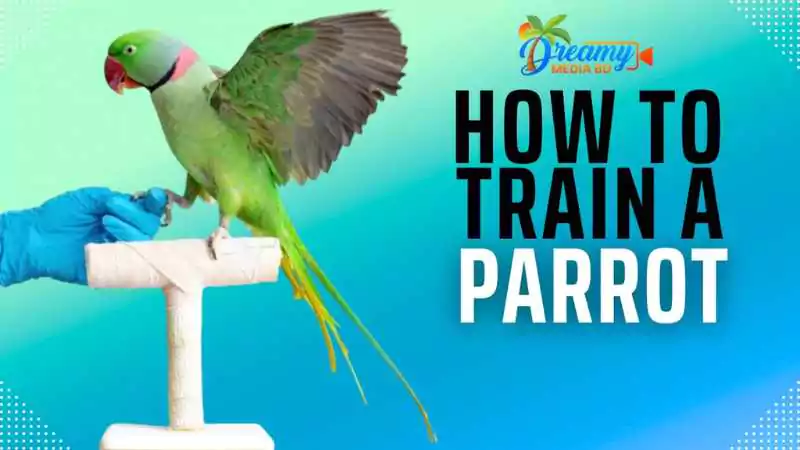I recently discovered something fascinating: parrots have the intelligence of toddlers! Who knew, right? I’ve been working on training my own Parrot, Kiwi, and it’s been such a rewarding journey. Not only for Parrot’s mental stimulation but also for my own sanity.
Why is training your Parrot so important?
Well, imagine this: you’re a new parrot parent, and your feathered friend is squawking endlessly, biting, or perhaps, is too shy even to interact. It’s frustrating, isn’t it? That’s where the magic of training comes in.
And you also want to know how to train a parrot?
To train a parrot, begin with accessible commands like “step up.” Give treats and use a clicker for good behavior. Teach your Parrot to touch a stick or your hand. Always reward them when they do well. You can also try more fun tricks as they learn. Training helps your Parrot be happy and helps you both get along better.
This blog is your go-to guide for transforming these challenges into triumphs. Let’s dive in and turn your pet into a companion and partner in communication and fun!
You can also read: Easy Steps to Teach Your Bird to Fly
Why You Should Train Your Parrot
Training your Parrot is essential for both you and your pet. It helps build trust and strengthens your bond with your bird. Teaching your parrot basic commands like “step up” establishes a foundation for more advanced training.
The essential tools for parrot training include positive reinforcement, such as treats, and a clicker for clicker training. Touch or target training involves using a stick or your hand as a target for your Parrot to touch, which can lead to more complex tricks and commands.
There’s nothing quite like the bond you form with your Parrot. It’s like building a friendship; you need trust, respect, and patience.
Once Parrot felt safe around me, training sessions became our bonding time. The “step up” command is the first step in building this relationship, as it teaches your Parrot to step onto your hand or a perch.
I’ve found that training isn’t just about teaching tricks; it’s about understanding each other better. Parrot seems happier, and I swear, it’s like we’ve developed our little language! It is an essential part of responsible parrot ownership and can bring joy and fulfillment to you and your feathered friend.
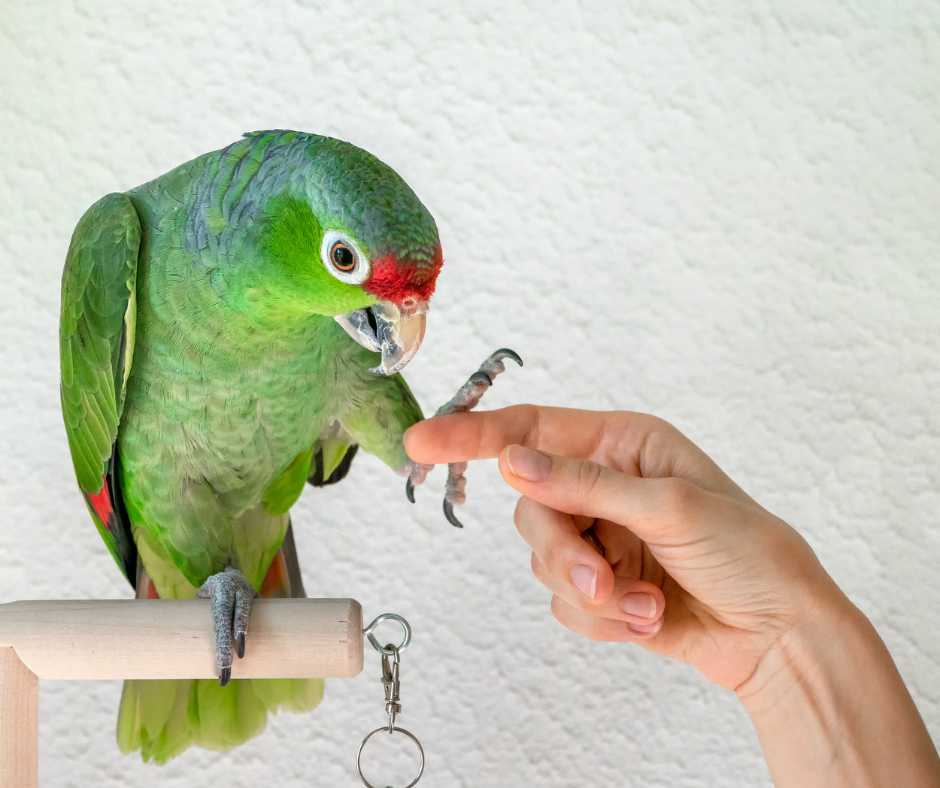
Essential Equipment
The right tools and gear can make any task more efficient and successful. When it comes to specific activities or professions, having the essential equipment is crucial for safety, productivity, and quality of work.
This section will explore the must-have items for specific tasks and industries, from cooking and gardening to construction and healthcare. So, let’s dive in.
Food Bowls
Using a food bowl correctly can help when training your Parrot. Here’s why it’s helpful:
- Routine: Using the same bowl for food and treats helps your Parrot get used to a regular schedule. This makes training easier because your Parrot knows what to expect.
- Rewards: The bowl can give your Parrot treats when it does something good. This helps your Parrot learn that doing certain things gets yummy rewards.
- Training Times: During training, you can put treats in the bowl. For example, if you’re teaching your Parrot to step on your hand, treat it in the bowl when it does it right. This encourages your Parrot to learn.
- Fun Challenges: You can use unique bowls that make your Parrot do a little task to get food. This keeps your Parrot’s brain busy and helps with training.
- Feeling Safe: The bowl can make your Parrot feel safe, especially in new places. A calm parrot is more accessible to train.
- Healthy Eating: Using the bowl helps you control how much and what your Parrot eats. This is good for keeping your Parrot healthy, which is essential for training.
So, a food bowl isn’t only for eating; it’s an excellent tool for training your Parrot. It helps with routine, rewards, learning, and keeping your Parrot happy and healthy.
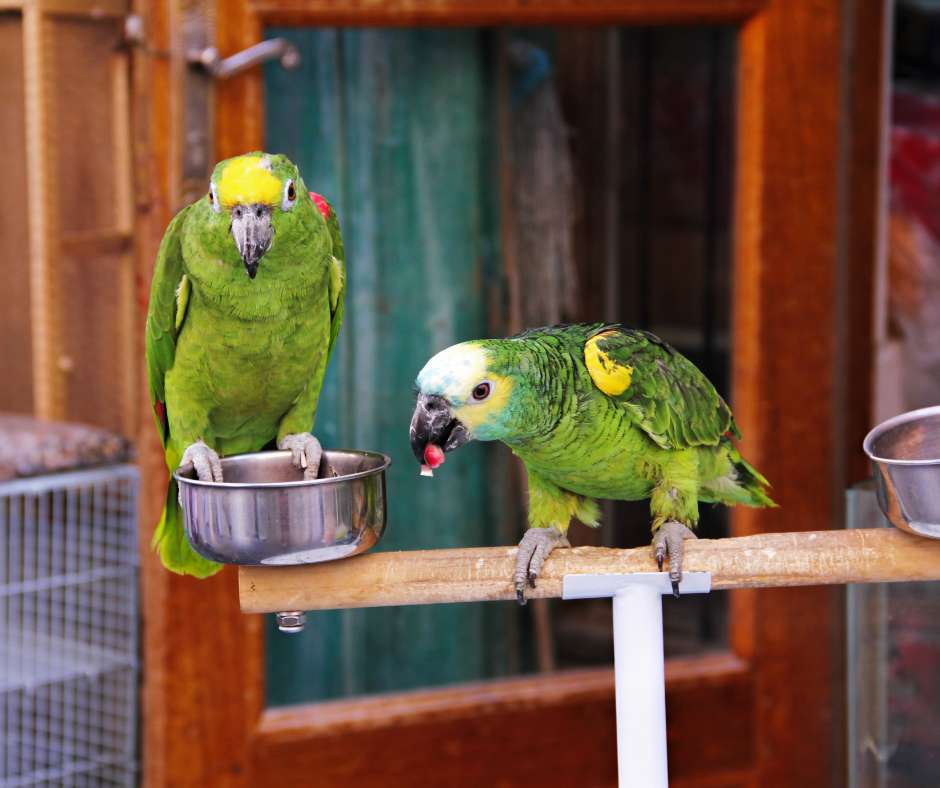
Target Stick
A target stick is helpful when training your Parrot. It’s a simple tool that can do a lot. You use it to show your Parrot where to go by having it touch the end of the stick. This helps you teach your Parrot to listen to you, move where you want, or do cool tricks.
Using a target stick makes training clearer and more fun for both you and your Parrot. It also helps you become better friends with your Parrot. Whether you’re starting to train your Parrot or have been doing it for a while, using a target stick can improve things.
Tape Recorder
A tape recorder can be an excellent tool for training your Parrot. It lets you record sounds or words and play them back. This is super helpful because parrots learn by listening and repeating.
When you play the exact words or tunes over and over, your Parrot can hear them clearly and start to copy them. This is fun for your Parrot and helps it learn to talk or sing.
Also, if you’re not home, you can leave the recorder playing, so your Parrot keeps learning even when you’re away. Whether you’re teaching your Parrot new words or songs, using a tape recorder makes it easier and more fun for you and your feathered friend.
Training Books and Other Materials
For training birds, there are some excellent books and online places to help you. You can read books like “Parrot Training: A Guide to Taming and Gentling Your Avian Companion” by Bonnie Munro Doane, “Clicker Training for Birds” by Melinda Johnson, and “The Perfectly Trained Parrot” by Rebecca O’Connor.
These books tell you how to teach your bird, understand what it does, and keep it happy and healthy.
Also, websites like YouTube are great for learning about bird training. You can watch videos made by bird lovers and expert trainers. They show you different ways to train your bird and make it easy to understand.
There are also websites and online groups where people who own birds talk about what they know. You can learn much from their sharing about training and caring for birds.
If you want to learn by doing, you can attend training classes or workshops at local bird clubs or pet stores. These places let you learn from people who know a lot about birds.
Remember, every bird is different. What works for one bird might not work for another. You must be patient and keep trying different ways to train your bird that match its way of acting and learning.
Understanding the Basics of Parrot Training
If you’re new to having a parrot, it is essential to learn how to train it. Training your Parrot is good for its mind and body and helps you two get along better. We’ll talk about easy ways to teach your Parrot: using kindness, regularity, and patience. This guide is for new or experienced parrot owners to train their birds well.
Understanding Parrot’s behavior
Getting a grip on Parrot’s behavior was like trying to understand a tiny, feathered enigma. Every quirk and chirp meant something, and decoding that was key to our training success.
Every interaction with your bird is a training session, so using tools like touch or target training and providing proper rewards is essential. Rewarding desired behaviors and ignoring undesirable ones helps effectively shape your Parrot’s behavior. This encourages positive interactions and strengthens your bond with your bird.
By learning how your Parrot acts, you can determine what it needs, what scares it, and what makes it act a certain way. This makes it easier to train and take good care of your Parrot.
In short, learning about your Parrot’s behavior is essential for having a happy and healthy friendship with it.
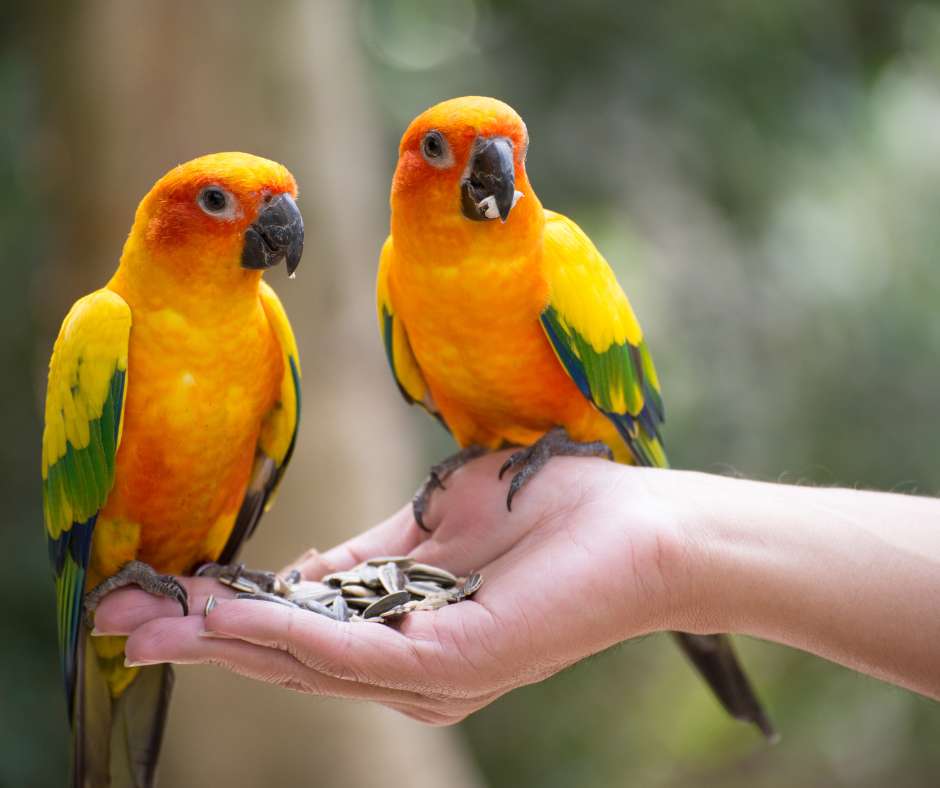
Establishing Positive Reinforcement
Positive reinforcement is an excellent way to train parrots. If you are used to using negative ways with your parrot, like telling it off, switching to positive reinforcement can help you and your parrot become closer friends.
This means giving your parrot treats, saying nice things, or toys when it does something good. This way, your Parrot happily learns what you want it to do. Training becomes more fun for both you and your Parrot.
It also makes your parrot trust and like you more, which makes you both happier. When you use positive reinforcement, your Parrot feels safe and sure of itself, which makes it a happier and healthier bird.
This way of training makes everyone in the house feel more peaceful. So, using positive reinforcement is a great way to train your Parrot and make your bond stronger.
The Learning Process & Human Speech
Teaching parrots to talk is both fun and unique! Parrots are intelligent birds that can learn human speech. The learning process is all about repetition and patience. When you repeat words or phrases to your Parrot, it picks them up.
It’s like how kids learn to talk. The key is to say the words clearly and use them often. Parrots love attention, so when you spend time talking to them, they’re more likely to try and talk back.
Remember to praise your Parrot when it tries to speak; this encourages it to keep trying. With time and practice, your Parrot can learn to say many words and even sentences, making your time together more fun and memorable.
Teaching Basic Bird Manners & Commands
Teaching basic bird manners and commands can be fun and rewarding. Start with the “step up” command, where your bird learns to perch on your finger or hand. Use a simple, clear cue like “step up” and guide their feet onto your hand. Patience and repetition are key.
Next, try teaching your bird to talk by saying words and phrases in a clear, upbeat tone. Please encourage them to mimic you and reward their efforts with treats or praise.
For waving or dancing, use a cue like “wave” or “dance” and guide their feet or wings to mimic the action.
To teach spinning or turning around, use a treat or toy to guide them in a circle while saying a cue like “spin” or “turn.”
For playing “dead,” hold your bird on their back while saying a cue like “dead bird.” Reward them when they stay still.
Taking a bow can be taught by guiding your bird’s head down while saying a cue like “bow.”
Finally, to teach fetch, throw a small toy and encourage your bird to bring it back to you with a cue like “fetch.”
Remember, patience and repetition are crucial to teaching your bird new skills. Practice regularly to keep their manners and commands fresh in their mind!
Advanced Techniques in Parrot Training
Training parrots can be fun and involves some extraordinary methods. One method is called “shaping behavior.” This means you slowly teach your Parrot to do something by giving it a treat for each small step towards doing the whole thing.
Another method is “target training.” This is when you teach your Parrot to touch something with its beak or foot. It’s excellent for teaching your parrot tricks or to come when called.
It’s important to use things your Parrot loves, like its favorite snacks or toys, as rewards. This helps your Parrot understand what you want it to do and keeps doing those things.
You can use these methods to teach your Parrot to talk, step up on your hand, or play with certain toys. These ways of training are not fun, but they also keep your parrot’s brain busy and help it stay healthy and happy.
So, teaching your Parrot using these particular methods and giving it the right rewards is a great way to help it learn and keep it feeling good.
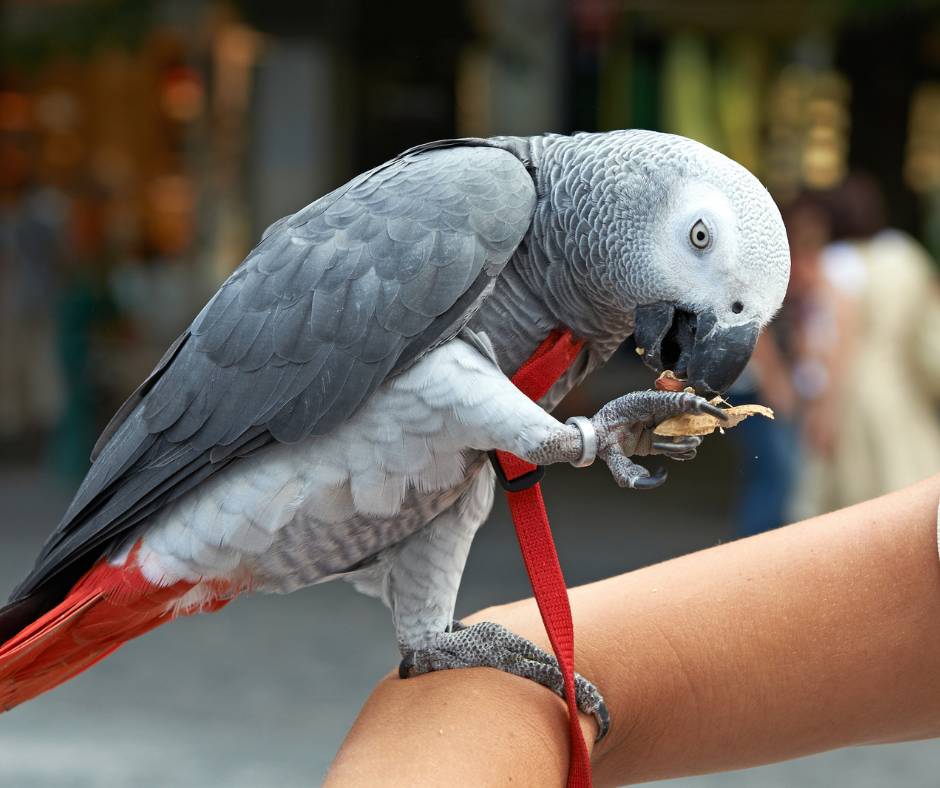
People Also Asked
How do you teach a parrot to talk?
To teach a parrot to talk:
- Talk to it often using simple words.
- Repeat words regularly.
- Reward it with treats when it tries to speak.
- Be patient and keep it fun!
How to tame a parrot?
To tame a parrot:
- Spend time near its cage daily so it gets used to your presence.
- Talk to it in a gentle voice and offer treats to encourage trust.
- Be patient and move slowly to avoid scaring it.
Over time, your Parrot will start feeling comfortable with you. Remember, each Parrot is unique, and taming can take time.
How do parrots memorize words?
Parrots memorize words by listening and repeating. They have a part in their brain that’s good at copying sounds they hear. When they hear people talk, they try to imitate the sounds. The more they hear a word, the better they get at saying it. It’s like how we learn songs by listening to them repeatedly!
How do you train a shy parrot?
Training a shy parrot-like Kiwi was a challenge at first. I learned that patience is vital. I’d sit by her cage and chat about my day, offering treats gently. Slowly but surely, she began to trust me.
Sum Up
In summary, if you’re thinking about training your Parrot, remember it’s not about the tricks. It’s about building a bond full of trust and mutual respect. Parrot isn’t just a pet; she’s a part of my family, and training has brought us even closer.
Remember, start with simple commands like “step up,” use positive reinforcement like treats and clickers, and be patient and consistent. Training enhances your Parrot’s mental health and strengthens your bond, making your time together more enjoyable and fulfilling.
So, embrace the journey of training and enjoy the rewarding bond it creates with your Parrot!

